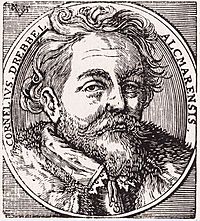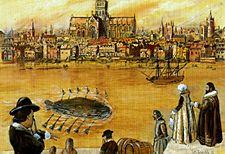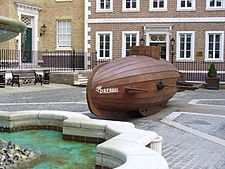Cornelis Drebbel facts for kids
Quick facts for kids
Cornelis Drebbel
|
|
|---|---|

Portrait of Drebbel, c. 1631
|
|
| Born | 1572 |
| Died | 7 November 1633 (aged 60–61) |
| Education | Hendrick Goltzius |
| Occupation | Engineer, inventor |
| Spouse(s) |
Sophia Jansdochter Goltzius
(m. 1595) |
| Children | 6 |
Cornelis Jacobszoon Drebbel (born 1572 – died 7 November 1633) was a clever Dutch engineer and inventor. He is famous for building the very first working submarine in 1620. Drebbel also made important discoveries in many areas. These included how to measure things, how to control systems, and how to use optics (light and lenses). He also made breakthroughs in chemistry.
Contents
About Cornelis Drebbel
Cornelis Drebbel was born in Alkmaar, Holland, in 1572. His family belonged to a group called Anabaptists. After attending school in Alkmaar, he went to an Academy in Haarlem around 1587.
At the Academy, he learned from famous teachers. These included Hendrik Goltzius, who was an engraver and painter. Drebbel became very good at engraving pictures onto copper plates. He also became interested in alchemy, which was an early form of chemistry.
In 1595, Cornelis married Sophia Jansdochter Goltzius. She was Hendrik Goltzius's younger sister. They lived in Alkmaar and had at least six children. Four of their children lived to adulthood.
Drebbel first worked as a painter, engraver, and mapmaker. He was always looking for new ideas. In 1598, he received a special permission, called a patent. This patent was for a new water-supply system and a type of clock that seemed to run forever.
Around 1600, Drebbel was in Middelburg. There, he built a special fountain. In this city, he likely learned about grinding lenses. This skill later helped him create a magic lantern and a camera obscura.
Life in England and Prague
Around 1604, Cornelis Drebbel and his family moved to England. King James I of England probably invited them. They lived at Eltham Palace. Drebbel worked on special shows called masques for the royal court. He was part of the court of Prince Henry, the king's son.
Drebbel amazed the court with his inventions. These included a machine that seemed to move forever, called a perpetuum mobile. He also showed off automatic and water-powered organs. His optical instruments were also very impressive.
News of his genius spread across Europe. In 1610, Drebbel and his family moved to Prague. He was invited by Emperor Rudolf II. The Emperor was very interested in art, alchemy, and magic. Drebbel showed his inventions there too.
In 1611, Rudolf II lost his power to his brother, Archduke Matthias. Drebbel was put in prison for about a year. After Rudolf died in 1612, Drebbel was set free. He then returned to London. Sadly, his supporter Prince Henry had also died. This left Drebbel in financial trouble.
Later Life and Legacy
Drebbel used his special glass-grinding machine to make optical instruments. He made compound microscopes with two curved lenses. There was always a high demand for these tools.
In 1622, Constantijn Huygens was in England as a diplomat. It's possible he learned how to grind glass from Drebbel. Huygens might have then taught his son, Christiaan Huygens, who became a famous scientist.
Towards the end of his life, in 1633, Drebbel was involved in a plan. This plan was to drain the wet lands, called the Fens, near Cambridge. At this time, he was living in London and was quite poor. He even ran a pub. Cornelis Drebbel died in London.
Following the traditions of his Mennonite faith, Drebbel's belongings were divided. They were shared among his four children who were still alive when he passed away.
Drebbel's Amazing Inventions
Cornelis Drebbel was like the "Edison" of his time. He was a hands-on inventor and researcher. His inventions covered many fields. These included measuring tools, air pressure, optics, chemistry, and water-powered machines. He also worked with fireworks. He even registered several patents for his ideas.
Drebbel wrote essays about his experiments with air pressure. He also created beautiful engravings. One famous engraving was "The Seven Liberal Arts" on a map of Alkmaar. He helped make props for plays and moving statues. He even had plans to build a new theater in London.
He worked on designing torpedoes and naval mines. He also created special detonators. These used glass drops called Batavian tears. He also experimented with a powerful explosive called "fulminating gold."
Drebbel was known for his "Perpetuum Mobile," a machine that seemed to run forever. He built an incubator for eggs. He also made a portable stove or oven. This oven used fuel very well and could keep a constant temperature. It did this using a special regulator, like a thermostat.
He designed a solar energy system for London. He also showed off early air conditioning. He could even create lightning and thunder "on command." He developed fountains and a fresh water supply for Middelburg. He worked on draining wet lands near Cambridge. He also created early versions of the barometer and thermometer. He even designed a harpsichord that played using solar energy!
Chemistry Discoveries
Drebbel's most famous book was Een kort Tractaet van de Natuere der Elementen. This means "A short treatise of the nature of the elements." It was published in Haarlem in 1621. He also helped invent mercury fulminate, an explosive. He found that mixing certain chemicals like "spiritus vini" (alcohol) with mercury and silver in "aqua fortis" (nitric acid) could cause explosions.
Drebbel invented a chicken incubator. He also created a mercury thermostat. This device automatically kept the incubator at a steady temperature. It was one of the first machines to use feedback control. He also developed and showed a working air conditioning system. Many people also believe Drebbel invented the first working thermometer.
The Scarlet Dye
There's a story about how Cornelis discovered a special dye. He was making a colored liquid for a thermometer. He accidentally dropped a flask of "aqua regia" (a strong acid) onto a tin window sill. He noticed that the tin made the color of carmine much brighter and longer-lasting. This led to the discovery that stannous chloride could make colors much more vibrant.
Cornelis didn't make much money from this discovery. However, his daughters, Anna and Catharina, and his sons-in-law, Abraham and Johannes Sibertus Kuffler, started a very successful dye business. One dye works was set up in 1643 in Bow, London. The color they produced was called bow dye. The recipe for this "colour Kufflerianus" was kept a family secret. This new, bright red color became very popular all over Europe.
Optics and Lenses
Drebbel is known for creating an automatic machine to grind lenses very precisely. He also improved telescopes. He made the first compound microscope, which was called the 'lunette de Dreubells'. He also worked on the camera obscura and the laterna magica. These were early versions of cameras and projectors. He also made Dutch or Batavian tears, which are special glass drops.
The Compound Microscope
Some historians believe Drebbel invented the compound microscope. This happened when he was working for the Duke of Buckingham. The device appeared in Europe around 1620. The earliest report is from 1619. The Dutch Ambassador, Willem Boreel, saw a compound microscope owned by Drebbel in London. He described it as about eighteen inches long and two inches wide. It was supported by three brass dolphins.
In 1621, Drebbel had a compound microscope with two convex lenses. Many people at the time, including Christiaan Huygens, gave Drebbel credit for inventing the compound microscope. However, others also claimed the invention. For example, Dutch spectacle-maker Johannes Zachariassen said Drebbel stole the idea from him and his father, Zacharias Jansen. Also, Galileo Galilei used his telescope as a type of compound microscope after 1610.
In 1624, Galileo saw Drebbel's microscope design in Rome. He then created an improved version. He sent it to Federico Cesi, who founded the Accademia dei Lincei. Cesi used it to illustrate Apiarum, his book about bees.
The Submarine


One of Drebbel's most amazing achievements was building the first working submarine in 1620. He built it while working for the English Royal Navy. He created a submarine that could be steered. It had a wooden frame covered in leather.
Between 1620 and 1624, Drebbel successfully built and tested two more submarines. Each new one was bigger than the last. His final (third) model had six oars. It could carry 16 passengers! This model was shown to King James I himself and thousands of people in London.
The submarine could stay underwater for three hours. It could travel from Westminster to Greenwich and back. It cruised at a depth of about 12 to 15 feet (4 to 5 meters). Drebbel even took King James on a test dive in this submarine under the Thames. This made King James I the first king to travel underwater!
This submarine was tested many times in the Thames. However, the navy officials were not excited enough about it. So, it was never used in real battles. More recently, some people have suggested that the stories about the submarine might have been a bit exaggerated. They think it might have been more of a semi-submersible. This means it could travel partly underwater, perhaps helped by the river's current. However, partially or fully covered boats were not new at that time. They had been used before and always caused a lot of excitement.
Namesake
A small lunar crater on the Moon has been named after him. Also, a street in Delft, the Netherlands, called "Cornelis Drebbelweg," is named in his honor.
In late 2019, a gin called Drebbel Gin was created. It honors his legacy and his great inventions.
See also
 In Spanish: Cornelius Drebbel para niños
In Spanish: Cornelius Drebbel para niños


